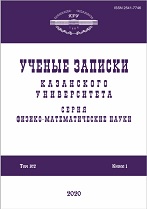|
This article is cited in 1 scientific paper (total in 1 paper)
Impact of a liquid jet on a wetted wall
T. S. Guseva
Institute of Mechanics and Engineering, FRC Kazan Scientific Center, Russian Academy of Sciences, Kazan, 420111 Russia
Abstract:
Some results of the numerical study of the impact of a cylindrical water jet (150–350 m/s) with the hemispherical head on a solid flat wall covered with a thin layer of water are presented. The numerical approach is based on the CIP-CUP method. The comparison is performed for the shock wave patterns, the zones with tensile stresses, and the wall load for a very thin layer (when the level of wall load and the load distribution are close to the jet impact on a dry wall) and for a relatively thick layer (when the load level decreases by more than 2 times and the load distribution is almost uniform). The tensile stress level indicates secondary cavitation. With an increase in the layer thickness, the size of the zone with tensile stresses increases and the stress level relatively slightly decreases. The effect of the jet velocity on the characteristics of the load and on the time dependencies of the maximum and average pressures for different layer thicknesses is considered in more detail. It is found that an increase in the jet velocity causes no significant change in the character of the wall load distribution, the change in the load level can be approximately estimated by the corresponding change in the water hammer pressure, and the size of the area with the maximum pressure increases. The maximum average pressure on the dry wall depending on the jet velocity is obtained, and it is well approximated by the water hammer pressure. With an increase in the layer thickness, the maximum average pressure on the wetted wall decreases from the water hammer pressure (which can be treated as a one-dimensional estimate in this case) the more, the lower the jet velocity. Thus, the influence of non-one-dimensional effects, which determines the damping effect of the layer, increases with a decrease in the jet velocity.
Keywords:
jet impact, liquid layer on а wall, wall load, CIP-CUP method.
Received: 08.10.2020
Citation:
T. S. Guseva, “Impact of a liquid jet on a wetted wall”, Uchenye Zapiski Kazanskogo Universiteta. Seriya Fiziko-Matematicheskie Nauki, 163, no. 2, Kazan University, Kazan, 2021, 117–127
Linking options:
https://www.mathnet.ru/eng/uzku1585 https://www.mathnet.ru/eng/uzku/v163/i2/p117
|

| Statistics & downloads: |
| Abstract page: | 207 | | Full-text PDF : | 115 | | References: | 22 |
|




 Contact us:
Contact us: Terms of Use
Terms of Use
 Registration to the website
Registration to the website Logotypes
Logotypes







 Citation in format
Citation in format 
